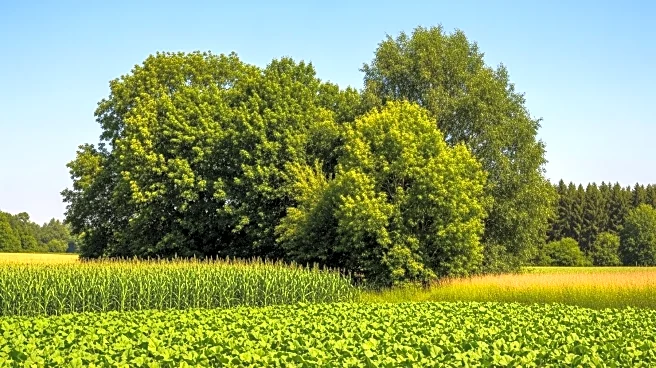What's Happening?
Agroforestry, the practice of integrating crops with trees, is gaining attention for its potential to support forest health and biodiversity, enhance carbon sequestration, and generate economic benefits for local communities. This approach involves planting trees in open agricultural fields or cultivating specific crops beneath existing forest canopies. Forest-based agroforestry aligns with Indigenous and traditional land stewardship practices, offering a sustainable method to combat climate change. The practice is seen as a way to slow the effects of monocultures by infusing biodiversity into landscapes, thereby functioning as carbon sequestration. Despite its benefits, agroforestry initiatives have sometimes focused more on planting trees rather than managing existing forestland, which is crucial for supporting forest ecosystems, rural livelihoods, and climate mitigation.
Why It's Important?
The significance of agroforestry lies in its ability to address multiple environmental challenges simultaneously. By enhancing biodiversity and carbon storage, agroforestry contributes to climate mitigation efforts. It also supports rural communities by providing sustainable harvesting opportunities, thereby improving livelihoods. The practice helps replenish soil degradation, which is a major issue in intensive farming, and promotes ecological health through enhanced biodiversity and tree regeneration. As climate change continues to alter forest health, agroforestry offers a viable solution to protect forests from threats like invasive species, forest fires, and soil degradation. This approach is particularly effective in tropical regions, where tree planting yields strong climate cooling effects.
What's Next?
Future efforts in agroforestry may focus on better science and policy to improve nature-based solutions for climate mitigation. Governments are encouraged to support these initiatives to protect the world's forests effectively. Controlled burning, thinning tree cover, and eradicating invasive species are examples of forest-friendly farming practices that can be adopted. As agroforestry practices evolve, they may play a crucial role in global and regional efforts to sustain forest ecosystems and their social, economic, and environmental functions.
Beyond the Headlines
Agroforestry's integration into farming practices represents a shift towards more sustainable agricultural methods that prioritize ecological balance. This approach not only addresses climate change but also fosters a symbiotic relationship between agriculture and forest ecosystems. The practice's roots in Indigenous land stewardship highlight the importance of traditional knowledge in modern environmental strategies. As agroforestry gains traction, it may influence broader agricultural policies and encourage a move away from monoculture farming, promoting a more holistic view of land management.











